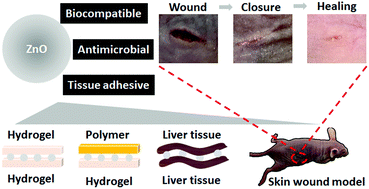ZnO nanoparticles as an antimicrobial tissue adhesive for skin wound closure†
Abstract
Tissue adhesives have emerged as alternatives to suturing and stapling in the treatment of reconnection of injured tissues. They can be accurately applied to the regions of body that are not easy to access in a minimally invasive way without a high level of training. Recently, it was demonstrated that nanoparticles can directly glue hydrogels or tissues without the need for in situ polymerization or crosslinking. For example, silica nanoparticles can serve as connectors between tissues and exhibit adhesion even in the presence of blood. This work reports the adhesive effect of two antimicrobial nanoparticles, i.e. titanium dioxide and zinc oxide nanoparticles, between hydrogels, hydrogel/polymer, and liver tissues. These two nanoparticles exhibit comparable or even better adhesive effects in comparison to silica nanoparticles. In a skin wound mouse model, zinc oxide nanoparticles achieve successful wound closure and aesthetic wound healing, suggesting their capability as an effective antimicrobial tissue adhesive.

- This article is part of the themed collection: Journal of Materials Chemistry B Emerging Investigators


 Please wait while we load your content...
Please wait while we load your content...